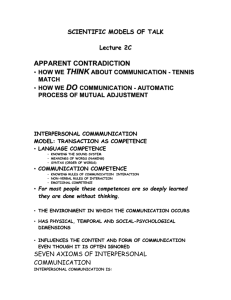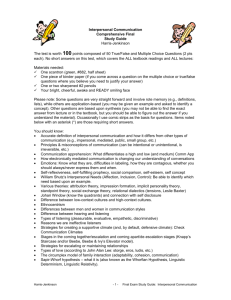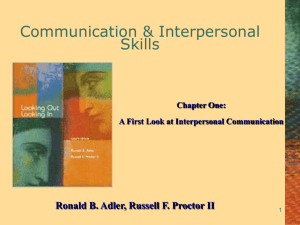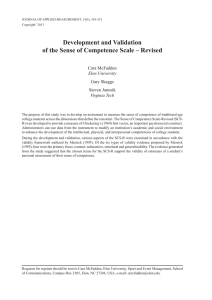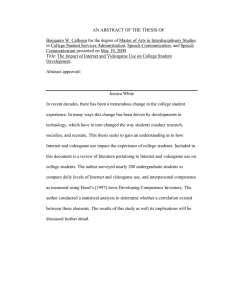Orientation - Bakersfield College
advertisement
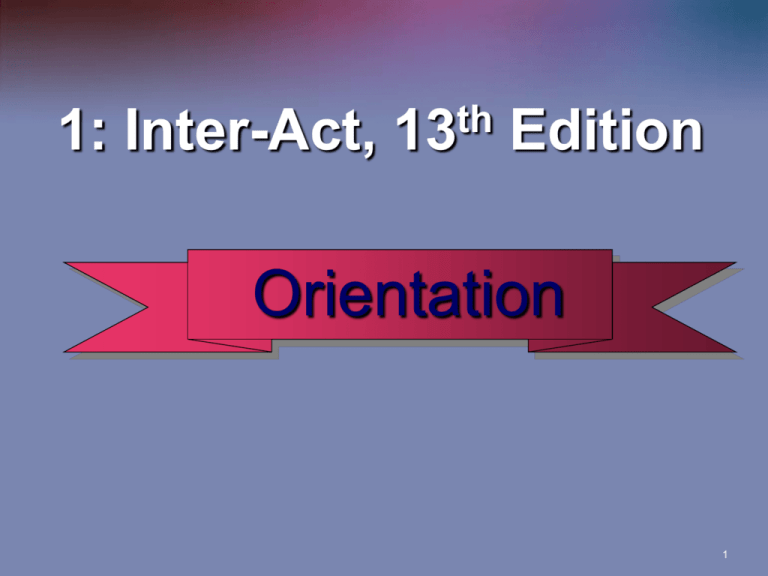
1: Inter-Act, th 13 Edition Orientation 1 Interpersonal Communication The complex process through which people express, interpret, and coordinate messages in order to create shared meaning, meet social goals, manage personal identity, and carry out relationships 2 Purposes of Interpersonal Communication • • • • Share meaning Meet social goals Manage our personal identity Conduct our relationships 3 Interpersonal Communication Process • Process: systematic series of actions that leads to an outcome • Message production: actions you perform to send a message • Message interpretation: activities performed to understand intended meaning • Interaction coordination: activities performed to adjust behavior to partner 4 Message – a performance that uses words, sentences, and/or nonverbal behaviors to convey the thoughts, feelings, and intentions of the speaker Canned Plan – mental library of scripts Script – text that instructs you what to say in a specific situation 5 The Communication Setting • Physical Context – where communication takes place, the environment, the distance between participants, seating, time of day • Social Context – the nature of the relationship • Historical Context – the background of previous communication • Psychological Context – moods & feelings • Cultural Context – beliefs, values, attitudes, meanings, social hierarchies, religion, notion of time, and roles of the participants 6 Noise • External noise – the sights, sounds, and other stimuli that draw people’s attention away from intended meaning • Internal noise – the thoughts and feelings that interfere with meaning • Semantic noise – distractions caused by the speaker’s words that interfere with meaning 7 8 Social Media Context • Social Media: technologies that facilitate communication and interaction • Digital communication: electronic transmission of digitally encoded information 9 Social Network Common interests, beliefs, knowledge Friendship Groups of individuals connected by Careers Family ties Institutions 10 Traits of Social Media Technology • Facilitates social interactivity • Takes time to send and receive messages (temporal structure) • Lacks social cues • Can be stored and replicated • Potentially reaches a large audience • Allows mobility 11 Principles of Interpersonal Communication • Is continuous • Is transactional • Is irreversible • Is situated • Is indexical 12 Communication Is Continuous • Interpersonal communication can be verbal or nonverbal. Therefore, we are always sending messages to others— whether we are aware of it or not! 13 Communication Is Transactional • Each person gives and receives messages, feedback. • Each person gets needs met and helps others satisfy needs. • Each person is changed with each interaction. 14 Communication Is Irreversible Once an exchange has taken place, we can never ignore it, take it back, or pretend it did not occur. 15 Communication Is Situated • All communication occurs within a communication setting. • Setting affects how messages are produced, interpreted, and coordinated. • Meaning is dependent upon the situation. 16 Communication Is Indexical • Index (or measure) of the emotional temperature of a relationship • Trust: the extent to which partners rely on, depend on, and have faith that their partner will not intentionally harm them • Control: the extent to which each person has power or is “in charge” of the relationship • Intimacy: degree of emotional closeness, acceptance, and disclosure 17 Ethics of Interpersonal Communication “A set of moral principles held by a society, a group, or individual” 1. Truthfulness and honesty 2. Integrity 3. Fairness 4. Respect 5. Responsibility 6. Empathy 18 The Dark Side Bright Side Ethical Appropriate Hard Dark Side Ethical Inappropriate Easy Dark Side Unethical Appropriate Evil Dark Side Unethical Inappropriate 19 Diversity – variations between and among people • Culture • Sex • Age • Class • Physical characteristics • Sexual orientation 20 Culture – systems of knowledge shared by a relatively large group of people Culture is a critical concept to communication because “every communicator is a product of his or her culture.” -Anderson 2000 21 Communication Competence Competence is the impression that communicative behavior is both effective and appropriate. Competence can be enhanced by: • Increasing communication knowledge • Increasing communication skills • Increasing communication motivation 22 Developing Competence Knowledge 1. Acquire interpersonal communication knowledge • Effective messages • Appropriate messages 2. Emotional Intelligence: ability to monitor your own and others’ emotions 23 Developing Competence Skills • Micro communication skills: message templates, “lines” • Communication skill scripts: mental texts that include micro communication skills 24 Developing Competence Motivation • Unlearn old ineffective scripts. • Learn new scripts. 25 Behavioral Flexibility 1. Make a prediction about appropriate communication. 2. Enact that type of communication. 3. Pay attention to reactions. 4. Either change communication or not. 26 Writing Communication Improvement Plans • State the problem. • State the specific goal. • Outline procedure for reaching the goal. • Devise a method of determining when the goal has been reached. 27

